Future Fabulators
Table of Contents
FoAM's A-Z Lecture
Lecture notes by Maja Kuzmanovic, at Future Fictions, Z33 in Belgium on the 16th of December 2014
What is FoAM
FoAM a transdisciplinary network for speculative culture with studios in Brussels, Amsterdam, Falmouth and Stockholm. What do we mean by speculative culture? You might be familiar with speculative fiction - sci-fi, horror, fantasy, folklore - these are stories about alternate worlds, where laws of physics and reality can be otherwise. By reading them we can view the world around us from a different vantage point. Speculative culture (a term coined by Bruce Sterling) takes on a similar role - it re-imagins how life could be otherwise, when we prototype possible tomorrows today from multiple points of view.
My work is that of a limited man who must deal with a limitless situation“ –Paul Virilio
One of the central things we do at FoAM is to bring people together from different lines of work, create frameworks for them to explore issues they care about, provide a context with enough freedom to experiment and explore edges between their interests, thoughts and actions. From these encounters and collaborations a range of hybrid works emerge: from immersive experiences, to participatory workshops, publications, games, systems, augmented gardens or synaesthetic dinners.
Our work is best encompassed in our motto “grow your own worlds”. It is process-based, it grows and evolves. We follow a “grow-your-own” philosophy with each of us accepting an agency and responsibility to design our lives, skirting the edges of what is known and 'permitted'. And finally we like growing worlds - creating experiences, interconnected wholes that can’t be reduced to a 'product' or a 'service' but function as prototypes of the cultures we speculate about.
All of this might sound quite abstract, so i’ll explain it by using one of our current projects as an example. It is called Future Fabulators, and it is through this project that we got involved in the Future Fictions exhibition and co-created the Futures Lab with its programme of workshops and aperos. This talk is about FoAM’s approach to futures and how this translates into our activities in the Futures Lab and Future Fabulators.

FoAM’s approaches to futures
At the heart of Embodied Foresight is the development of capacity to sit with uncertainty and not- knowing, to develop tolerance and acceptance of the discomfort that comes with doubt. A healthy relationship with doubt is seen as central to good practice of the future as non-predictable and in-determinant.-Alex Burns
Working with futures has implicitly been a part of FoAM’s work since our formation in 2000. More recently, since 2009 it emerged as an explicit topic, when we explored what cultural resilience might be like, as we face economic, societal and environmental turbulences.
We concluded that to be resilient, an individual (and a culture) should be flexible enough to adapt to whatever happens, but at the same time have a vision of where they’d like their future to go. Vinay Gupta called this 'visionary adaptation' - a capability of a person or a system to have a desired future that is held loosely enough so it could be adjusted to changing circumstances.
The idea that we should have an image of where we’d like to go, while keeping our eyes wide open to see what emerges (and adapt accordingly) is nothing new. Pre-historic shamans and fortune tellers through out the ages called these tactics 'divination' and 'invocation'. Divination concerns seeing emergent patterns in a chaotic world, and invocation focuses people’s intention on creating a preferred future. Reading coffee grounds and tarot cards, holding rites of passage, writing sci-fi novels could all be seen as ancestors of the current practice known as foresight, futurology or futures thinking. In the Futures Lab we compiled a visual overview of the “history of futures”, that puts our work in a longer perspective. Nowadays when we talk about foresight, we usually mean the formal discipline that exists more or less since the second world war, known as 'futures studies’ and 'strategic foresight'. As appropriate to the late industrial and information age, it developed as formalised methods focusing on analysis of massive amounts of data and creating predictive models of where the future might go.
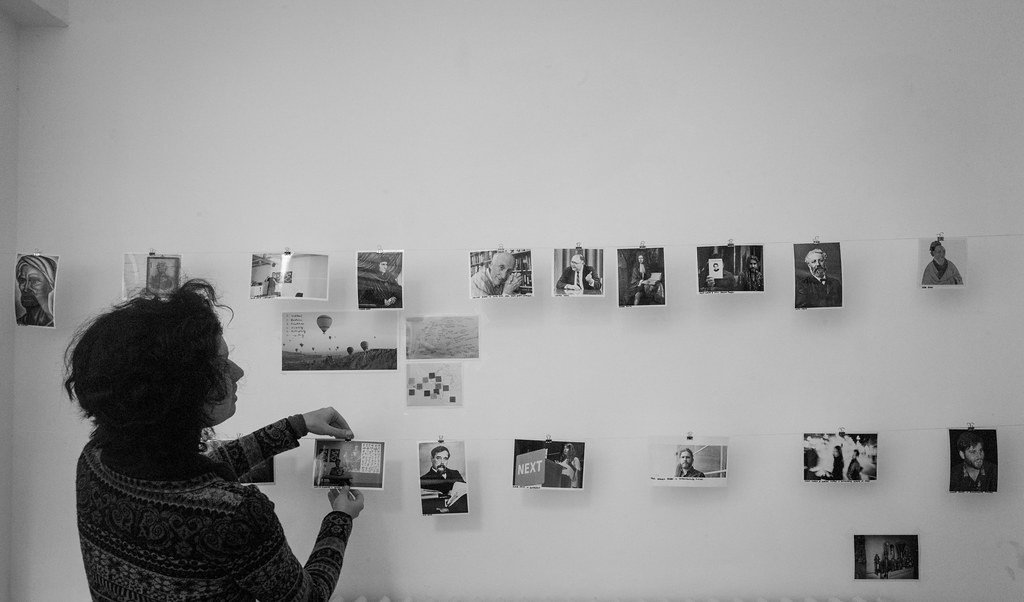
In the last decade or so, there have been developments in and around futures studies that brought the field closer to design, performance and experience. As we at FoAM have been growing towards futures, the futures have also grown towards us.
Another recent development in futures that FoAM is a strong proponent of is the growing need to see future as a commons. Both from inside and outside of the field people have been advocating that futures thinking should be more widespread. Something like a futures literacy for all. Karen has been using this term to describe her motivations behind Future Fictions as well.
‘Ambient foresight’ is (about) building futures awareness subtly, into the mental environment. Rather than demanding attention with fireworks, an ‘ambient’ future awareness is gentle, or perhaps almost invisible. Ambient foresight contains the seed of an idea for gentle suggestions relating especially to you, right now, that may help. (…) In a society where futures are a reflexive, ordinary part of everyday life, we would be constantly envisioning, forecasting, fine-tuning and collectively deciding what to do next. We would be designing and redesigning society on a collective, ongoing basis. - Stuart Candy
Ambient foresight advocates futures thinking becoming a part of our daily life, existing alongside our ability to reflect on what happened in the past or having an overview of a present situation. With ambient foresight we are equally able to imagine and prototype what the future might bring and allow this knowledge to inform our actions in the present.
Both making the futures more experiential and approaching the future as a commons have been our motivations for designing the Future Fabulators project. Together with our partners, Time’s Up in Austria, M-ITI in Portugal and AltArt in Romania we set ourselves a goal to 'unshock the future' as the futurist Scott Smith likes to say.

What I mean by unshocking the future is that we want to build a bridge between the 'big future' - that tends to include jet-packs and flying cars - and the 'mundane future' - in which we decide to study at a well know university, find a job, get married and live a fulfilling life. We want to find connections between people’s dreams and reality, to develop an ability to integrate thinking and talking about the future in the experience of daily life.
How do we do that? To begin with we believe that futuring - the practice of future thinking - must involve different types of learning and knowing. The mainstream foresight practice is at the moment quite constructivist and data driven, which can give a false sense of certainty and predictability. In our view this cannot paint the full picture.
The only thing that is predictable is change. - Pema Chödrön
Keen embodied observation and interaction in the present are the beginning of a foresight process. Analysis of what’s going on is definitely needed, but this must move into synthesis, co-creation, as well as somatic and interpersonal experience. This might sound as just a string of vague words, so let me give you a few examples to clarify what I mean. I’ll begin with our research of formal foresight processes, then talk about synthesis of futures in narratives, move on to prototyping and end with experiential futures.
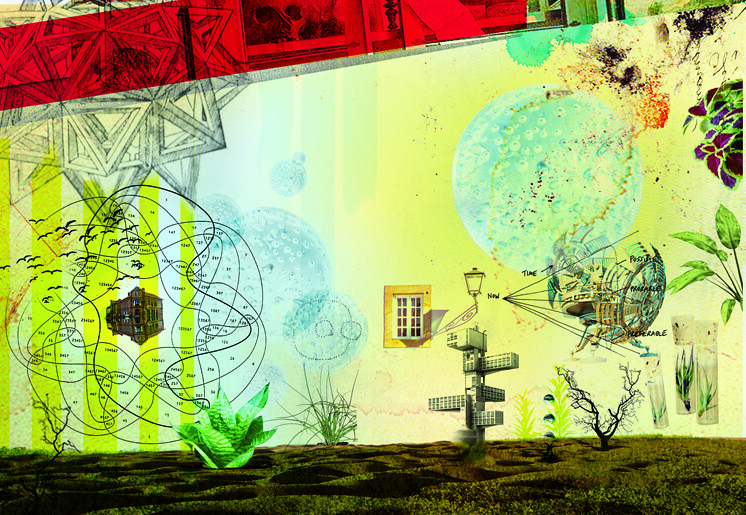
Unpacking methods
In the beginning of 2014, when Karen Verschooren (the curator of Future Fictions) approached us about collaborating for the exhibition, we were involved in researching formal foresight methods from business, academia, the military and policy making - which is where most foresight experts earn their daily bread. The more we researched, the more it became apparent just how opaque, fragmented and convoluted the field is, and how much time and effort is needed for people outside of futures to understand the methods, let alone be able to apply them. Our ideal of having a widespread futures literacy seemed very far away indeed…
We began to unpack the heavy, long and involved processes used in foresight into a set of agile techniques that could be combined in different settings, by amateurs and professionals alike. For example, a common futures process might cost tens of thousands of Euro and last for months, if not years. We are developing open source techniques, so that anyone could apply them in their own contexts, with the process taking hours, days or a few weeks - depending on availability of the people and resources. We’re currently putting together a publication to collect these different techniques and make them available as recipes for futurists of all persuasions to try out and adapt. Several processes used in the Futures Lab, by FoAM, Extrapolation Factory and Pantopicon will be featured in this publication, which we aim to launch by June 2015.

One aspect that has allowed us to shorten and lighten the process is that we began working with people’s assumptions rather then spending months collecting data and 'horizon scanning' or collecting information about emerging trends. This appeared to produce more cliches than when experts bring new information, but it also allowed the participants in futures workshops to be more engaged and also observe how their assumptions distort the images of the future. For example, when working with a group of environmentalists, their futures obviously favoured environmental over social or economic developments, a cultural transition network created futures where culture was always an alternative to the status quo and a group of mothers with children desired a future where work and life aren’t as separated as today. If the process is well designed, these “distortions” can show the participants where their blind-spots and resistance to change lies.
In Future Fabulators we are interested in experimenting with futures processes in a range of contexts. They are commonly used to help make business decisions, designing policies, products and services (or critiques thereof), but we wanted to see how they would work for more obscure and less pragmatic topics, such as creating story-worlds based on lucid dreaming, or designing futures of doing nothing. We found it quite liberating to speculate on often forgotten elements of the future, that aren’t seen as serious as say the often discussed 'future of work' or 'future of the city'. Working beyond topics that are narrowly market, conflict or policy driven reminds us that futures tend to woven from many things we take for granted and might overlook as trivial. In a speculative process nothing can be considered too trivial or too ridiculous…
Any useful idea about the future should appear to be ridiculous (Dator’s 2nd Law of the Future)- Jim Dator
Co-creating stories
Aside from experimenting with different foresight methods, one of the important works for Future Fabulators is synthesising glimpses of futures into narratives. To create stories together we borrow techniques from creative writing, storytelling as well as theatre and combine them with foresight methods. We synthesise 'future fictions' (or tales from alternative pasts and parallel presents) with groups of people in participatory and co-creative processes. In foresight this synthesis (aka worldbuilding) tends to be outsourced to 'consultants', but we found that crafting future narratives to be the most enjoyable and creative part of the foresight process, that should be shared with everyone involved. The outcome of such a process depends strongly on the participants' engagement. We can therefore never know beforehand where a scenario process will take us.
This seems strange to some people who are used to foresight being an expert-driven field. For example, when we prepared the Futures of Doing Nothing workshop, I got a call from a journalist who wanted to know what the futures of doing nothing will be. I told her that I couldn’t say, as the answers had to emerge from the workshop process. She seemed quite disappointed that she couldn’t get sound-bite with an optimistic prediction by a futurist.
The best attitude for a serious futurist is not pessimism or optimism, but a deep sense of engagement. -Bruce Sterling
As an example of creating stories together with a community I’d like to mention a recent workshop on Godsheide Futures, for a green neighbourhood of Hasselt. As part of Futures Lab, FoAM worked with the University of Hasselt and the Godsheide Inhabitants’ Union to create future scenarios for the neighbourhood and translate them into a newspaper ”Het Belang van Godsheide in 2024. The abstract mega-trends and 'big futures' came to life as 'day-in-a-life' diary entries, newspaper articles and tableau vivants.
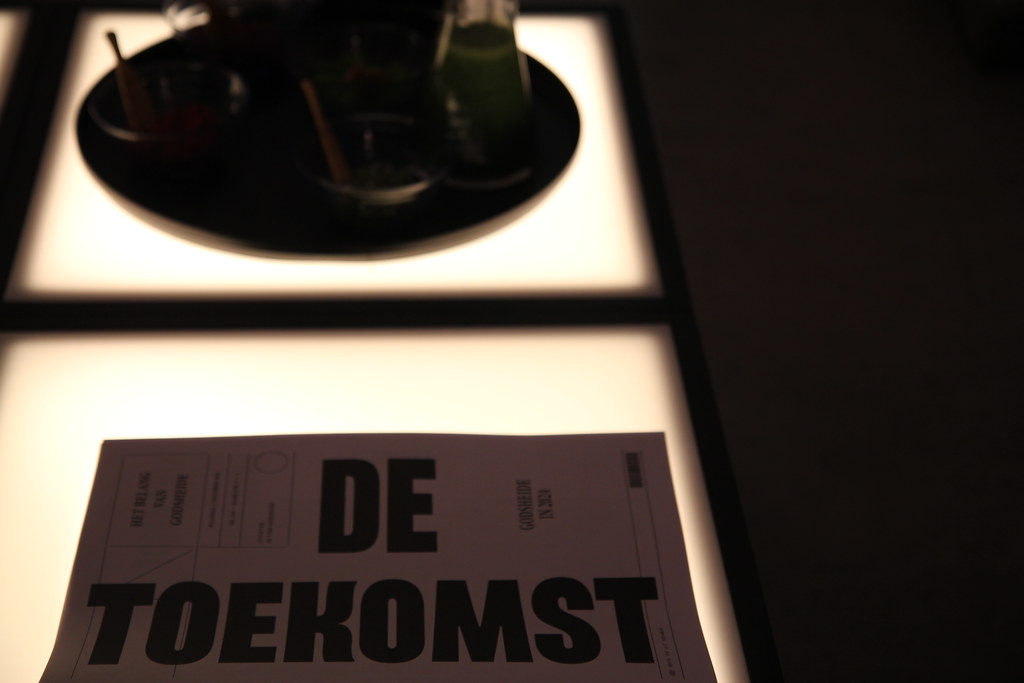
The inhabitants created the stories and headlines, as well as acting as the protagonists of the staged photographs. Students and researchers then put together the newspaper that was launched in the exhibition last Friday. The newspapers are now spread across the city to fuel discussions about urban planning, community building, infrastructure and green spaces in Godsheide. More importantly though, the stories also became seeds for actions that the inhabitants can initiate themselves: a neighbourhood co-operative, a crowd-funded school, or a new co-caring and co-working space in the church. If we believe that foresight has some elements of invocation, some of these stories might become reality by 2024.
When participants co-create their images of the future, they pour their life experience into them and scenarios become more alive and relevant to the people involved. We all know how to tell stories, so it’s a medium that is accessible for all. With Future Fabulators we’re looking at different types of stories we could use in the futuring process - from the usual written short stories, to full-blown transmedia stories and physical narratives.
…A work that would let us escape the limited perspective of the individual ego, not only to enter into selves like our own but to give speech to that which has no language, to the bird perching on the edge of the gutter, to the tree in spring and the tree in fall, to stone, to cement, to plastic… - Italo Calvino
Prototyping futures
Physical narratives connect stories to the next topic: the need to prototype futures. Even though stories are more accessible than the common 100+page foresight reports, they are still rather intangible and speak primarily to our brains. By prototyping stories in objects, tools and even fully immersive spaces, we can make them more concrete and tangible. To understand them we use multiple senses and learn by touching, handling, seeing, hearing and moving.
Prototyping futures also includes design fiction, where people create objects from the future. Designers often use a familiar context (say a product catalogue, or an educational video), but then infuse the content with ideas about the future. A few weeks ago in Futures Lab we had a workshop by the collective Extrapolation Factory, who worked with the participants to create speculative products and then design infomercials for a fictional TV shopping network. Similarly, Pantopicon hosted a workshop on the futures of democracy that ended in creating a range of objects we might find as archaeological curiosities in a museum in our far future.
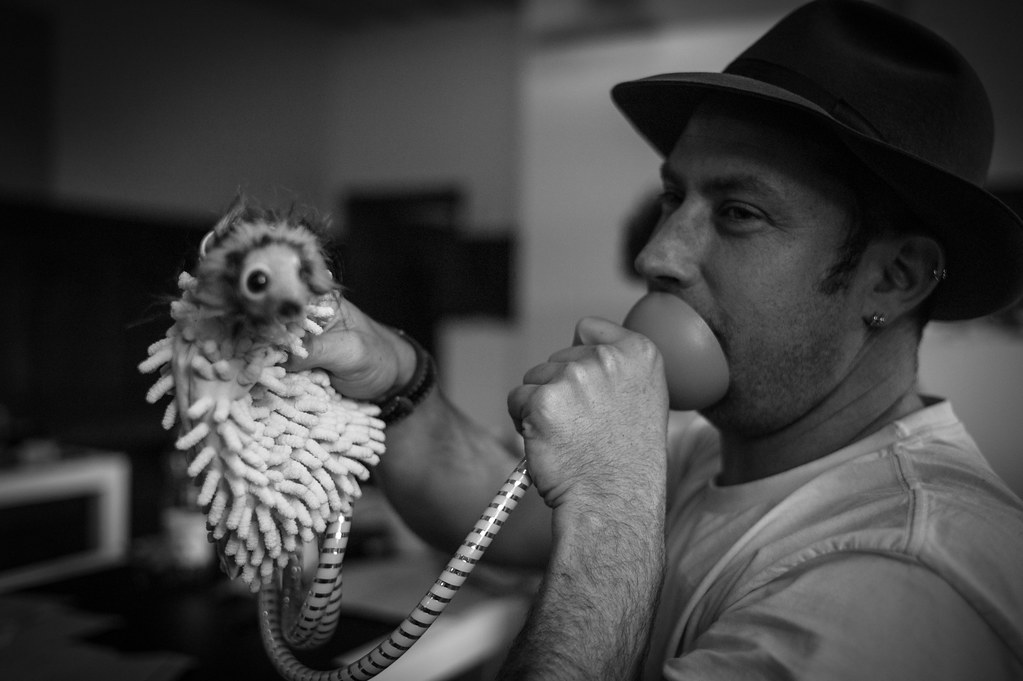
In another Futures Lab workshop that FoAM hosted, we used futures card games by Situation Lab, Near Future Laboratory and Changeist to create future objects through play, thereby significantly lightening the process. What such prototypes do is exercise your speculative muscles and make different futures more tangible. There are many similar examples to be found online, but also in the Future Fictions exhibition next door - so if you haven’t yet, have a look in the coming weeks until the 4th of January.
Pre-enacting futures
Finally, we come to FoAM’s main topic of interest: experiential futures. This term is coined by the futurist Stuart Candy in his PhD thesis, but has since taken a life of its own. In experiential futures we take prototyping the future a step beyond designing objects and into designing immersive experiences and situations. At FoAM we call these situations pre-enactments or prehearsals and describe them as experiences where you can rehears or enact different futures before they happen.
Although this might sounds like role playing, it is closer to a practice of improvisation, meditation and introspection. While in prototyping futures we focus on making them tangible, in experiential futures we target people’s awareness. We ask you to speculate about what you would do and who you would be if you ended up in different (future) situations. Pre-enactments make it possible to see yourself as if from a different vantage point.
By placing participants in unfamiliar but ultimately safe situations, our automatic behaviours, habits, thoughts and emotions become apparent. This can be uncomfortable and confronting for some, but for people who commit to the process it can have lasting effects on their lives. While people can read through stories or handle objects with a certain distance, in an immersive experience they viscerally feel what it might be life to live in a given situation.
It is well known from disaster drills - as for example the recent Operation Storm Tide in Oostende a few weeks ago - that direct experience provides a deeper learning than facts assimilated from books. In design you’re probably familiar with experience prototypes that operate on similar principles - before building an expensive product or service, you try it out with your users using mock-ups.
A pre-enactment is a similar 'future preparedness drill' that we believe can enhance personal and collective resilience. We are still experimenting with different pre-enactment formats and durations, and I’ll describe a few to illustrate what I mean.
The simplest pre-enactment is a set of instruction cards that can be used in people’s daily lives. The instructions are distilled elements of a scenario that can remind the participants to alter their routine for a while and act as if they were living in a different scenario right here, right now. We have developed such instruction cards for the Futures of Doing Nothing and Lucid Dreaming workshops. You can find them in the Futures Lab at the exhibition.

A more complex pre-enactment is the one we created for the opening of Future Fictions. It was an 'edible pre-enactment', where we designed a Food Futures reception in which you could taste what foods in alternative futures might taste like. In a collapse scenario for example we might eat primarily fermented goods, cultivated mushrooms, seaweed and insects, while in a transform scenario permaculture, food science and design make eating into an art-form. You can find more about the scenarios and the menu in the process notebook in the Futures Lab. In a similar vein we also designed cocktail parties and tasting dinners where the participants would come as themselves in a particular future and would 'network' and exchange stories and tasks as if the party happened in another time. This required them to reflect on what might have happened to them from now until then and what kind of person they might have become if they would be subjected to a different reality. This approach to pre-enactment is characterised by creating a known situation where you know what to do (e.g. a party, a symposium, a market…) but you arrive as your future self, with different experiences and stories than what you might have in the present. It requires you to be believable, speculate and improvise conversations with other participants.
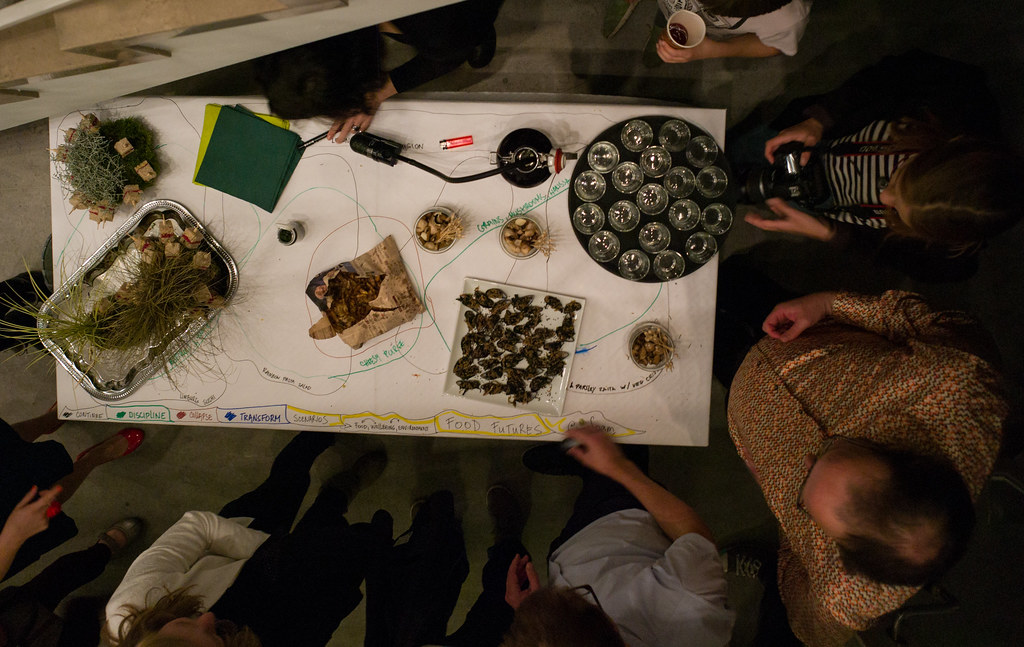
The goal of forecasting is not to predict the future but to tell you what you need to know to take meaningful action in the present. -Paul Saffo
Finally there are the full-blown pre-enactments that can last for hours, days or months, where you place yourself in an unfamiliar situation and observe how you act and react to it. The situation can be either already existing or it is created by the participants.
When I say existing situations, I mean visiting places that already exhibit aspects of our possible futures. For example in the beginning of Future Fictions Nik Gaffney, one of FoAM’s collaborators travelled to the Russian Arctic and experienced what it is like to live and work in a contested geopolitical zone of industrial expansion and pollution. Most of us know about it, but it is so abstract that it doesn’t mean much for our daily life. But for Nik to experience it meant that he could more easily make parallels between such a dark ecology, his life and our work. To feel the impact of sulphur pollution on his lungs and skin is very different to seeing it illustrated as a graph. The present in the Russian Arctic might be similar to an apocalyptic future of Belgium in a few decades, or it might not. That’s not the point. Being able to experience it today can help understand its potential and how we can adapt to uncertainty and possible futures.

The future is already here — it's just not very evenly distributed. -William Gibson
Some futures exist today - but are - as Gibson says - not evenly distributed. Others don’t exist yet at all. To pre-enactment such futures we borrow techniques from ARGs and LARPS to create compelling immersive 'worlds'. Here the participants create a world from scratch - through their behaviours, actions and interactions, props, costumes, technologies and media. The worlds can be as simple as an improv exercise without much scenography, or integrate a physical narrative where the elements of the scenario are embedded in objects through the space. It all depends on time and budget available.
A few weeks ago one of the participants of the Futures of Doing Nothing workshop pre-enacted her future as a guide in significant rites of passage. We held the pre-enactment at FoAM, transforming the lab into a workspace for rituals. It happened during a work-day, so on the surface it might have seemed that nothing much changed, but all of us adjusted our roles, routines and actions to accommodate this future scenario. At the end, not only did the participant learn about what it might be like to be herself in her preferred future, it also opened up discussions at FoAM about things from this scenario that we might incorporate into the our organisation. In other words, by pre-enacting a future we seemed to invoke it in the present and even began seeing it subtly become real.
I’d like to end my talk with this image of desirable futures becoming our presents, when enough intention and commitment has been poured into the process. This statement also includes a hidden warning to be careful what you wish for, as before you know it, it might come to pass…
Cherish failure. Preferably other people's. We fail our way into the future. -Stuart Brand
Finally, in FoAM’s spirit of participatory foresight, I’d like to invite you to finish with a short closed-eye visioning exercise that might be appropriate for this time of night. I invite you to travel to your desired future, eight years from now.
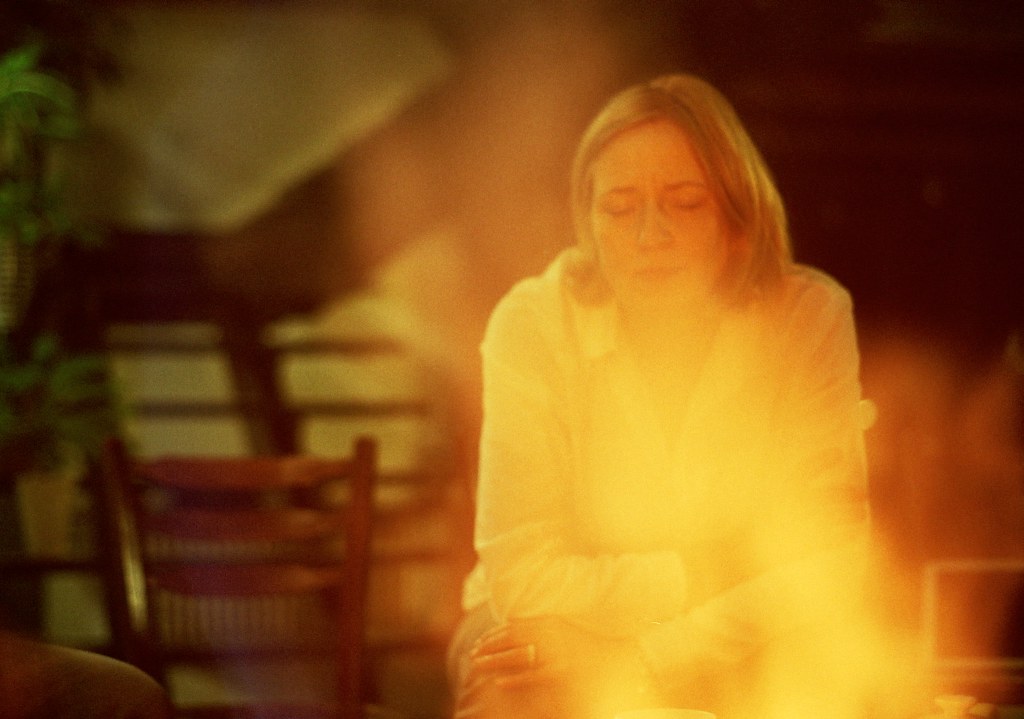
Close your eyes and take a few deep breaths. In and out… with this breath a month further from now, with this outbreath another year passes… in and out, in and out… until we arrive at Z33 in this room on the 16th of december 2022…
Keep your eyes closed and spend some time exploring the room…
Where did you come from… Who are you on the 16th of december 2022… What is your life like… How are you feeling… Who is around you… What is happening… Why are you here… Where will you go afterwards… Is someone waiting for you… Where is your home… What does it look like?
Imagine yourself preparing to go to sleep… What is your bedroom like? Where do you sleep - in a bed, a hammock, on the floor, or somewhere else? Lie down and as you do, memories from your life in the last eight years begin flashing in your mind's eye: Atmospheres you liked living in… people you liked being with… situations that made you feel alive… environments where you felt comfortable… perhaps some significant events… and finally you remember yourself and all the things you found important as your life unfolded from 16 december 2014 to the 16th of december 2022…
Don’t forget to breathe… in and out, in and out… Now with each breath travel back in time… back to 2021, 2020, 2019, 2018, 2017, 2016, 2015 and back to here and now…
Slowly open your eyes and stretch out, arrive back in your body, in this room. Look around and greet the people around you.
Welcome back & thank you very much…

More FoAM's Future Fiction photos can be found on Flickr.
